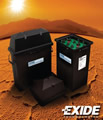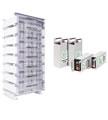Wet Cell, or Flooded batteries
are the most common lead-acid battery
in use today. Wet cell deep cycle batteries are one
of the best storage solutions for the average Off
grid system. They can be forgiving to a point
and are not as delicate as the Gel
and AGM's when it comes to
an overcharge situation. The cost and life cycle is
certainly lower than the alternatives. Wet cell deep
cycle batteries have thick lead plates that are alloyed
with antimony, and are flooded with an electrolyte
and water mix.
The electrolyte levels must be checked monthly and
topped off with distilled water. Wet cell batteries
can be ruined by not maintaining proper electrolyte
levels. Wet cell batteries should never be installed
in living areas, and should be stored in a compartment
with ventilation. This is due to the gas that is given
off as a natural result of charging. High quality
deep-cycle wet cell batteries will offer good performance
and are available in many dimensional sizes and Ah
capacities.
A gel cell is a VRLA lead-acid
battery with a gelified electrolyte.
VRLA stands for valve-regulated lead-acid and is the designation
for low-maintenance lead-acid rechargeable batteries.
Because of their construction, VRLA batteries do not require
regular addition of water to the cells.
VRLA batteries are commonly further classified as:
• Absorbent glass mat battery
• Gel battery
Gel cell batteries are often referred to
as sealed lead-acid (SLA) batteries due
to their non-leaking containers, but they are not completely
sealed, the valve regulation system allows gas to be expelled.
Unlike a traditional wet cell lead-acid battery,
these batteries do not need to be kept upright and are non-spillable,
therefore can be operated in virtually any position. However
installation upside down is not recommended.
As Gel cells are sealed and cannot be re-filled with
electrolyte, controlling the rate of charge is very
important, they are prone to damage if gassing is allowed
to occur.
They must be charged at a slower rate (C/20) to prevent
excess gas from damaging the cells. Gel cells use slightly
lower charging voltages than flooded cells and thus
the set-points for charging equipment have to be adjusted.
Most good quality inverters commonly used in solar
electric systems can be set to limit charging
current to the batteries. Gel cells can be used in virtually
any flooded wet cell application (in conjunction with
well-regulated charging) as well as applications where
wet cells cannot be used.
Because of their unique features and benefits, gel cells
are particularly well suited for:
• Deep Cycle Deep Discharge Applications (Portable
Power, Electronics, Solar Applications)
• Standby and Emergency Backup Applications (UPS,
Emergency Lighting)
• Unusual and Demanding Applications (Air-transported
equipment, Marine Starting)
Absorbed Glass Mat (AGM) batteries are the latest step
in the evolution of lead-acid batteries.
AGM 's are typically VRLA, valve-regulated lead-acid and
are a type of low-maintenance lead-acid rechargeable
battery. Because of their construction, VRLA
batteries do not require regular addition of water to
the cells.
VRLA batteries are commonly further classified as:
• Absorbent glass mat battery
• Gel battery
Instead of using a gel, an AGM uses
a fiberglass like separator to hold the electrolyte
in place. These types of batteries have all the advantages
of gel cell batteries, but can take much more abuse.
They are also called "starved electrolyte",
as the mat is about 95% saturated rather than fully
soaked. That means that they will not leak acid even
if broken.
Some advantages over gel cells and flooded deep cycle
batteries:
• they cannot spill, even if broken, as all
electrolyte (acid) is contained in the glass mats.
In addition, since there is no liquid to freeze and
expand, they are practically immune from freezing
damage.
• charging voltages are the same as for any
standard battery - no need for any special adjustments
or problems with incompatible chargers or charge controls.
• low self-discharge - from 1% to 3% per month
is usual. This means that they can sit in storage
for much longer periods without charging than standard
batteries.
Basically, an AGM can do anything a gel cell can,
only better. However, since they are also sealed,
charging has to be controlled carefully or they can
be ruined. AGM batteries are superior for marine and
RV applications.
Practically all solar batteries used in PV systems
and most backup systems are lead-acid type batteries,
this includes the standard flooded wet cell battery,
dry gel/dry cell, sealed and agm (absorbed
glass mat). A deep-cycle battery is designed to deliver
a consistent voltage as the battery discharges and can
be charged with a lower current than regular batteries
making them ideal for solar system set ups.



 AGM
Batteries
AGM
Batteries